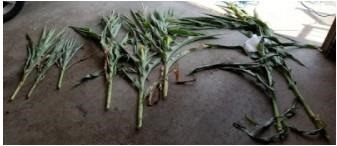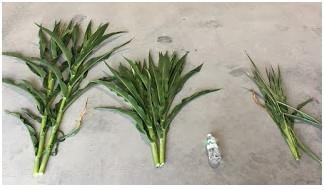By Emily Popp and Nathan Drewitz et.al
The 2021 drought has been hard-hitting for much of Minnesota. In some areas corn has dried down enough that it is already being chopped for silage. Aside from the areas where plants are barren (no pollination or ear development) with little green tissue remaining, it is often best to delay corn silage harvest as long as possible to allow for maximum development of the kernels and total dry matter.

Key Points
- Check for pollination. If corn successfully pollinated and has developing kernels, it is best to wait to chop for silage to allow more dry matter to accumulate.
- If plant moisture falls below 70%, it may be necessary to begin silage harvest, depending on how the silage will be stored.
- If leaf tissue has already turned brown due to drought, these leaves will no longer photosynthesize, even if rainfall is received.
- Green leaves that have rolled continue to photosynthesize.
- Check pesticide labels to ensure preharvest intervals are followed.
- Check with your crop insurance agent before harvesting.
Are ears developing?
Check the ears and assess the status of the grain to help determine harvest timing. Fields with plants that have some grain development should be left for as long as possible to allow the grain to further develop. If rainfall is received, that grain will continue to fill, increasing dry matter and improving silage quality. If pollination was unsuccessful and ears are barren of kernels, harvest should occur as soon as the plant moisture is appropriate for storage.
The forage quality of drought-stressed corn silage is expected to be variable because of variation in plant height, maturity, and grain fill within a field. We can expect greater starch production with increased grain fill. If there is little or no grain, we can expect higher levels of crude protein and fiber content but decreased energy content compared to corn silage containing grain. Therefore, it is important to test corn silage for nutrient content as rations may need to be adjusted compared to corn silage in a more typical year.
Harvest moisture
Test the moisture level of corn silage before and during chopping. Silage moisture is an important factor in the ensiling process and the moisture content of drought-stressed corn can be deceiving. Even if the corn looks fired up and dried out, it may still contain over 70 percent moisture (Figure 1).
When testing for moisture, it's important to get a representative sample from the field (Figure 2). A Koster tester or microwave can provide an accurate estimate of the moisture level of the silage. It is important to test often because silage that is too wet or too dry will have storage issues. Silage chopped too wet can become clostridial and nutrients can seep from storage structures. Silage that is too dry will not pack well, increasing the potential for air pockets, mold, and storage losses. It is possible to add moisture to dry corn silage, but it is usually not feasible as it takes large amounts of water to increase moisture. For example, it takes 7 gallons of water per 1 ton of silage to raise the moisture level by 1% moisture.
The recommended moisture levels for the different storage options of corn silage are:
The recommended moisture levels for the different storage options of corn silage are:
- 65-70% for bunkers
- 60-70% for bags
- 60-65% for upright stave silos
- 55-60% for upright oxygen-limiting silos
- 40-55% for baleage

Figure 1. The three groups were tested separately and averaged together. Moisture = 75%.

Figure 2. The three groups were chipped into the same samples and tested. Moisture = 82%.
TEST FOR NITRATES!
Nitrates taken up by plants are normally incorporated into amino acids, the building blocks of proteins. The conversion of nitrates to amino acids usually occurs in green leaf tissue. Drought conditions can cause nitrates to accumulate in the plants, especially in the lower one-third of the stalk (Table 1).
Table 1. Nitrate concentrations in drought-stressed corn.
| Plant part | Nitrate-nitrogen |
|---|
| | ppm |
| Leaves | 64 |
| Ears | 17 |
| Upper 1/3 stalk | 153 |
| Middle 1/3 stalk | 803 |
| Lower 1/3 stalk | 5524 |
| Whole plant | 978 |
Raising the cutting deck to a height of 10-12 inches to avoid the stalk that is highest in nitrates will decrease the nitrates in the silage, but also decreases tonnage. The whole-plant nitrate concentration should factor into the decision of cutting height.
Harvest should also be delayed a minimum of three days following a rainfall event, as a flush of nitrates can enter the plant, temporarily increasing nitrate concentrations.
If ensiled properly, one-third to one-half of the nitrates will be converted and released as a gas. Test the silage during feedout to ensure you’re not feeding unsafe nitrate levels, taking into account the nitrate level in the corn silage and the proportion of corn silage in the ration. Green chopping drought-stressed corn is not recommended as nitrates will likely be high without fermentation.
Chopping length also plays a role in the ensiling process. The theoretical length of cut for processed corn silage is ¾ inch and if not processed the length should be ¼ to ½ inch. If harvesting corn silage that is drier than recommended, decreasing the cutting size may help with packing. Using an inoculant can also increase the chances of successful fermentation. With reduced yields, it is critical to preserve the forage we do have.
For more information, see Navigating nitrate toxicity in feedstuffs.
Watch for silo gas
The nitrate-nitrogen that is released as a gas during fermentation includes various nitrogen oxide gasses that are lethal to humans and livestock. These gasses are heavier than air and will accumulate above the silage in a silo and can flow down the chute, into the silo room, and out the silo juice drain. Some of these lethal gasses are colorless and odorless, so as always use extreme caution around silos and have an emergency action plan in place.
Baling corn dry is challenging
If stacking or baling drought-stressed corn as dry hay, make sure to dry down to <20% moisture to avoid storage issues. This can be nearly impossible to do without ideal drying conditions. Since this material isn’t ensiled, it is especially important to test for high nitrates. Baleage is a better alternative to baling corn dry, as it excludes oxygen and will ensile if dense bales are made and wrapped properly. For bale silage it is best to bale at 40-55% moisture and wrap with a minimum of 6 millimeters of plastic (about 7-8 wraps).
Check Pesticide Labels
Before harvesting drought-stressed corn for forage, be sure to check the labels of any pesticides used in the crop. Be sure to follow the pre-harvest intervals listed in the label prior to harvest.
Contact your crop insurance agent
For insured crops, be sure to contact your crop insurance agent before harvesting or before changes are made to the crop to ensure coverage.
Source : umn.edu